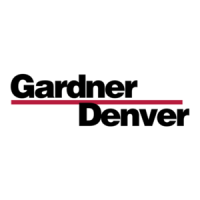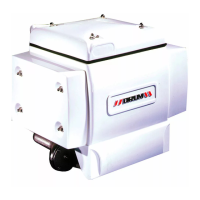SHUTDOWN TROUBLESHOOTING GUIDE (Continued)
Message
Action Needed
HIGH DISCH TEMP
This indicates that the controller has detected temperature in excess of
the programmed high temperature limit, or a high temperature rate of rise,
at the airend discharge. The most common cause for this is inadequate
package cooling. Ensure proper air flow for aircooled units, or adequate
water for water cooled units. Monitor temperature carefully during restarts
after servicing.
HIGH RESVR PRESS
HIGH RESRVR TEMP
HIGH SYSTEM PRESS
HIGH VIBRATION
LOW OIL PRESS
MAIN OVERLOAD
MAIN START ERROR
(while stopped)
MAIN START ERROR
(while running)
Pressure in excess of the programmed high pressure limit has been de-
tected. This shutdown will
occur if a loss of pneumatic controls occurs.
Check
the inlet valve, all control piping, solenoid valves, and all other con-
trol devices to find the cause for the inlet valve not closing. Other possible
causes are loose connections to the transducer, electrical noise and tran-
sients, or improper setting of the high pressure limit.
This indicates that the controller has detected temperature in excess of
the programmed high temperature limit, or a high temperature rate of rise,
at the air/oil separator. The most common cause for this is inadequate
package ventilation. Monitor the temperature carefully during restarts af-
ter servicing.
Pressure in excess of the programmed high pressure limit has been de-
tected. The most likely cause is other, higher pressure compressors on
the same air system; separate these from this compressor unit. Other
possible causes are loose connections to the transducer, electrical noise
and transients, or improper setting of the high pressure limit.
120 volts has been removed from terminal 7 of the terminal strip. This is
normally shipped jumpered directly to terminal 9, but the jumper may be
removed to add a field installed shutdown switch. Reset the external
switch,
The controller has attempted to start and load the compressor, but pres-
sure is not building up in the oil reservoir. This may indicate either a failure
of the motor to turn the compressor, or a failure of the inlet valve to open.
If the latter, check also the wiring and piping to solenoid valves IVO and
IVC; these are both turned on to load up the compressor.
The motor overload relay for the main compressor drive motor, located
within the electrical control box, has tripped. This indicates high motor
shaft load, low voltage, or excessive imbalance in the incoming power
(such as a blown fuse). Disconnect and lockout power, open the box, and
press the reset button - itwill click when reset. Measure motor amps, and
take corrective actions to get all currents within the motor nameplate rat-
ing. If overload relay has not tripped, check for the cause that 120 volts
was removed from connector 8-2 of the controller.
The controller has attempted to turn off the compressor, but is still receiv-
ing a return signal from the starter’s auxiliary contact. Check that the start-
er operates freely and that the contact block is properly installed on the
starter.
The controller has attempted to start the compressor, but did not receive
a return signal from the starter’s auxiliary contact, If the starter does not
pick up when attempting to start, check that connector 9 of the controller
is plugged in firmly, and check the starter coil. If the starter does pick up,
but the message appears, check that the auxiliary contact block is proper-
ly installed on the starter and wired to connector 8, terminal 4.
13-9/10-641 Page 63

